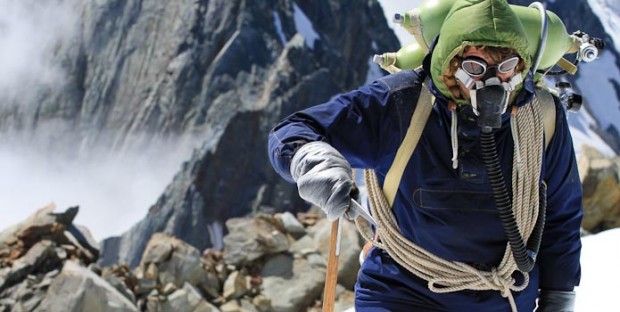The narrative-driven documentary Beyond the Edge, arriving on the 60th anniversary of the first successful Everest summit by Sir Edmund Hillary and Tenzing Norgay (played by Chad Moffitt and Sonam Sherpa in reenactments), is a stunning new digital 3D feature. Directed by Leanne Pooley, the story is expertly told via archival footage, newly shot reenactments, explanatory animations, and interviews, which propel the narrative forward.
The film is similar in approach to the IMAX style employed by Greg MacGillivray in his documentary work including 1998’s Everest (the top grossing institutional IMAX film of all time). While IMAX films typically feature on-screen narrators (typically those going on the journey or involved in scientific research) and a frame narrator (typically voiced by a celebrity), Pooley also includes audio interviews with the sons of Hillary and Norgay.

With access to Everest limited to one expedition a year, John Hunt’s 1953 group, with the backing of Great Britain, brings together the unlikely duo of Hillary, a New Zealander, with Norgay, one of twenty Sherpa guides for the expedition. Pooley also seamlessly integrates 16mm found footage alongside the newly shot 3D material, much of which is quite thrilling, if lacking the impact of MacGillivray’s film (as seen in a native 15/70MM legacy IMAX venue).
I suspect Beyond the Edge will have a strong life on the instructional venue circuit, particularly showing at science centers. As a history lesson, Polley serves the material well, while the film’s use of digital 3D is quite restrained (often images recede into the frame). The recreations are excellent, right down the props, visual effects and costumes, unlike a great deal of History Channel documentaries.

Pooley is skillful at orienting us on Everest through the journey, including how the film explains certain obstacles and options (notably a white knuckle sequence, as Hillary and Norgay reach the summit involving their oxygen supply). Every step of the journey is detailed and well-explained, making for a successful educational tool tracing two important trailblazers. At times it has the spirit of a PBS documentary, but the film somehow lacks the impact of native IMAX filmmaking.
Given recent developments in IMAX, including the backlash (rightfully so) over Digital IMAX and the conversion of traditional multiplex auditoriums to various large screen formats that lack impact (like ETX, XD, RPX and IMAX), it’s no wonder the filmmakers chose traditional digital 3D. The journey is worth taking, but perhaps will leave one wanting a little more.
Beyond the Edge premiered at TIFF. One can see our complete coverage by clicking below.


